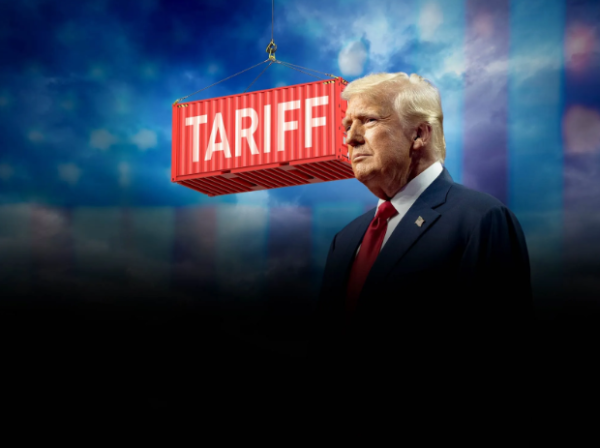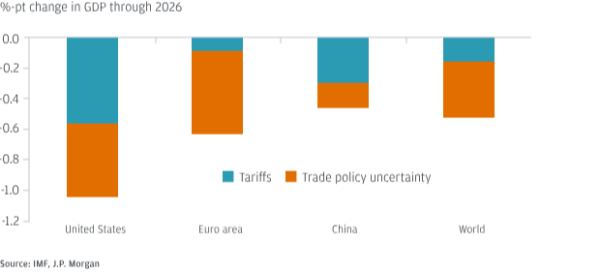President Donald Trump has announced a wide set of new tariffs, making a significant change in U.S. trade, industry, and consumer direction. The announcement came on April 2, 2025. It includes a 10 percent tariff on additional imported goods. Some countries will have higher rates with certain items taxed up to 50 percent. Trump described the move as a necessary correction to what he calls “decades of unfair trade.”

Recent History
This announcement was built upon Trump’s previous trade policies, including the 2018 tariffs on steel and aluminum as well as the 2020 trade war in China. The new tariffs are implemented as a new strategy to reduce the U.S. trade deficit and encourage domestic manufacturing (to make products in the U.S.). However, many argue that these “measures” could strain international relations and disrupt global supply chains, as countries may be impacted negatively by these decisions.
What the Tariffs Cover
A flat 10 percent rate applies to most imported goods, which started April 5. There are over 60 countries that will face additional tariffs. These rates vary from 17 to 50 percent and took effect four days later.
Some of the targeted nations include:
China: 34% tariff
India: 27% tariff
Japan: 24% tariff
The EU: 20% tariff
Lesotho (with the highest): 50% tariff
Impact on the Economy
Industry leaders and economists have mixed views. Some manufacturers are pretty welcoming of the changes, believing the tariffs will reduce overseas competition. Others, especially in the retail and auto sectors, however, are concerned. Higher import costs often mean higher prices for consumers. The auto industry, in particular, warned that rising costs for foreign parts could slow down production and raise sticker prices.
There’s also concern about inflation. Consumers may feel the effects; if businesses pass costs to consumers, electronics, cars, and everyday items could become even more expensive than they already are. This depends on how long the tariffs stay in place and whether suppliers absorb the costs or pass them along. Economists are watching closely to see how prices and supply chains respond.

Political Response
In Washington, the reaction has not been the same throughout. Some lawmakers on the Republican side support the move. They argue it’s long overdue. A few Democrats have agreed, especially those from states with large manufacturing bases. But many, on both sides, warn of unintended consequences.
Abroad, the response has been sharper. The European Union said it may bring a case to the World Trade Organization. Other countries, like Japan and India, have threatened their own countermeasures.
Legal and Diplomatic Fallout
The World Trade Organization might get involved soon. Several of the affected countries believe the tariffs violate existing agreements between them and the U.S. If the WTO (World Trade Organization) rules against the United States, it could lead to more issues. At the moment, diplomatic talks are taking place. Some allies are pushing for exemptions or special arrangements.
Business and Public Reaction
Across the country, business leaders are trying to adapt. Some domestic producers are optimistic. They believe the tariffs will give them a better chance to thrive. Others, especially those dependent on foreign parts or products, are getting ready for higher costs and impacts.

Looking Ahead
The White House has set a 90-day window for countries affected by the tariffs to negotiate new trade deals. If those talks fail, the duties will remain. Right now, no deals have been signed, although talks have started with several nations including Japan and India. What happens next will shape both the global economy and the U.S. political landscape. The outcome of these negotiations could affect businesses and even you.
Conclusion
Trump’s new trade policy has stirred controversy at home and abroad. The goals are clear. The risks are real. Whether the plan brings lasting change or sparks new conflict remains to be seen. Let’s hope for a bright four years for the U.S. and its economy.
We hope you enjoyed our second to last article, and be prepared for out last and best article of the year!
Works Cited
Burgess, Jack. “What are tariffs, how do they work and why is Trump using them?” BBC, 14 April 2025, https://www.bbc.com/news/articles/cn93e12rypgo. Accessed 17 April 2025.
Goldman, David. “Trump’s tariffs are inflicting serious economic damage and reigniting inflation, OECD says.” CNN, 17 March 2025, https://us.cnn.com/2025/03/17/economy/tariffs-oecd-forecast-economy-inflation/index.html. Accessed 17 April 2025.
Goldman, David. “Wall Street rattled by back-and-forth over Trump’s tariffs.” CNN, 3 February 2025, https://amp.cnn.com/cnn/2025/02/03/business/tariffs-trump-imports-us. Accessed 17 April 2025.
Lynch, David J. “The unconventional economic theory behind Trump’s sweeping tariff plans.” The Washington Post, 17 November 2024, https://www.washingtonpost.com/business/2024/11/17/trump-tariff-trade-imbalances/. Accessed 17 April 2025.